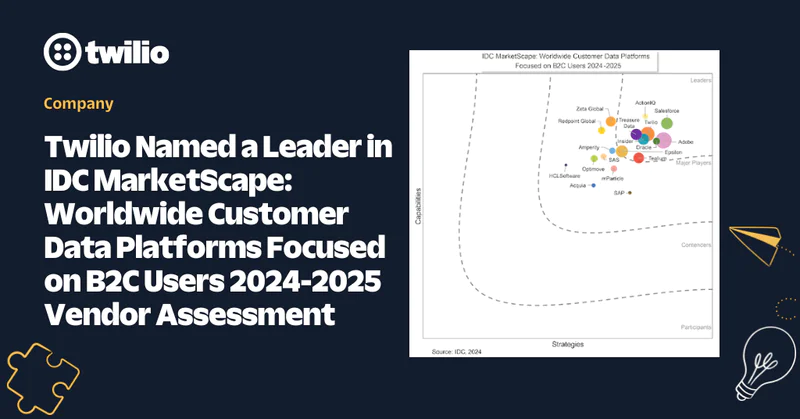Upstream Data Orchestration: The Key to Real-Time, 1:1 Personalization
Time to read:
Upstream Data Orchestration: The Key to Real-Time, 1:1 Personalization
As a marketer, you’ve probably felt the pain: your team is running cart abandonment campaigns, personalized emails, retargeting ads, and SMS reminders, but something’s off. Customers see inconsistent messages, some campaigns feel generic, and engineering keeps getting pulled in to troubleshoot why the same logic is duplicated (and breaking!) in three different tools.
Let’s talk about why this happens and how moving data orchestration “upstream” to your Customer Data Platform (CDP) can be a game changer for both personalization and operational efficiency.
The Problem: Siloed Campaign Orchestration Creates Fragmented Experiences
When campaign logic and audience targeting are managed vertically within each channel—email, SMS, ads, support—the result is a fragmented customer journey and shallow personalization. Common symptoms include:
- Fragmented audience targeting: Each platform knows a little, but none knows everything.
- Incomplete personalization: Campaigns only leverage basic signals—like “John abandoned a cart”—leaving out rich context like what was in John’s cart, his loyalty status, or browsing habits.
- Slow, missed, or inconsistent messaging: Siloed systems struggle to respond in real time to key intent signals.
- Duplicated logic, wasted resources: Engineering teams are stuck reimplementing business logic in every tool, creating complexity and risk.
The Old Approach: Working in Silos
Here’s what this looks like in practice:
- Your email platform, ad manager, and SMS tool each have their own idea of who is “in” the cart abandonment audience.
- Data doesn’t flow freely. Product details, loyalty info, or lifecycle stage live in different places—or get lost entirely.
- “Personalization” boils down to a first name and “you left something in your cart.”
- Marketers and engineers waste cycles maintaining the same logic in every tool.
- Real-time engagement opportunities slip through the cracks.
The Modern Approach: Move Orchestration Upstream to Your CDP
Now, imagine if you could:
- Unify customer profiles in realtime, combining data from your website, app, data warehouse, and anywhere else customers interact with your brand.
- Manage journeys and triggers centrally—define business logic once, and activate it everywhere.
- Empower every downstream engagement platform (email, SMS, ads, support, etc.) with rich, contextual payloads about each customer’s actions, preferences, and status with data from your unified profiles or data warehouse.
- Respond instantly to intent signals, triggering the right message at the perfect moment—no more waiting, no more inconsistencies.
Welcome to upstream orchestration with Twilio Segment CDP.
How a CDP in your Tech Stack Solves the Problem
A stack built with a real-time CDP like Segment, your data warehouse, and best-in-class engagement tools enables you to:
- Centralize and enrich customer data: Every action, trait, and behavioral signal—merged and accessible as a single source of truth.
- Move business logic upstream: Define journeys and triggers once in your CDP; downstream tools simply receive activation instructions.
- Power channel-agnostic personalization: Ensure every message—email, SMS, push, ads—is consistent and deeply personalized.
- Enable truly real-time, intent-based engagement: Reach customers the moment it matters, not minutes or hours later.
- Streamline operations: Marketers spend less time working around tech limitations; engineers maintain less duplicated logic.
- Improve governance and compliance: Data policies and consent managed centrally, enforced everywhere.
Upstream Orchestration in the Real World: Cart Abandonment Example
Let’s play this out with a familiar use case: cart abandonment.
Old way (downstream orchestration):
- Each tool (email/SMS/ads) watches for abandoned carts and attempts to trigger messaging.
- Each only knows “a cart was abandoned by John,” not what was in it, or John’s loyalty level.
- Personalization is generic (“Don’t forget your cart”), and responses can be slow, inconsistent, or even duplicative.
Upstream orchestration (with Segment CDP):
By moving orchestration upstream, you can add richer detail to emails and messages and centralize logic across all touchpoints, instead of duplicating it in each end platform.
- The CDP listens for the “cart abandoned” event (in real time) and combines it with contextual data: cart contents, price, user’s loyalty status, household info, and more.
- The CDP then triggers in your downstream tool:
- An email 30 minutes later with dynamic content personalized to what’s in the cart.
- An SMS if no purchase after 2 hours, referencing the specific deal the customer qualifies for.
- A retargeting ad if 24 hours pass without conversion—automatically suppressed if the customer eventually checks out.
Every message is powerfully personalized (e.g., “Use your loyalty points for 10% off these shoes you’ve been eyeing!”), and all channels are coordinated—without duplicating rules everywhere.
Strategic Benefits: Why This Matters for Scale and ROI
When you move data orchestration upstream:
- Audiences stay in sync—no more duplicate or out-of-date segments.
- Journeys become customer- and intent-driven—not tool-driven.
- Personalization gets powerful—messages reflect a customer’s full context, history, and eligibility.
- Operations get efficient—build logic once, activate it across all channels, and free up your engineers.
- Compliance gets simpler—one place to manage consent and governance.
This is how brands unlock scalable, always-on engagement—whether it’s onboarding, winbacks, loyalty programs, or anything else.
When Does Upstream Orchestration Add the Most Value?
Not every marketing campaign needs upstream orchestration. The real differentiator is campaign complexity and the level of real-time, cross-channel personalization required.
Keep it simple: For straightforward, single-channel campaigns like newsletters or one-time announcements, your Marketing Automation Platform (MAP), such as Braze or Iterable, is purpose-built to make these easy and effective. These tools excel at orchestrating and delivering direct, focused messages with maximum efficiency.
Supercharge with Segment: Segment Journeys shines for use cases where you want deeper personalization or need to coordinate messages across channels (email, SMS, ads, etc.) based on real-time customer behaviors. This is essential for:
- Real-time triggers (cart abandonment, onboarding, winback).
- Journeys that require unified audience logic and context-rich payloads (like specific cart items, loyalty status, browsing behavior).
- Lifecycle programs that must react quickly and consistently to intent signals in any channel.
Segment doesn’t replace your MAP, it supercharges it. By orchestrating logic and injecting rich, real-time data upstream, your downstream MAP tools deliver more personalized, timely, and scalable communications. This lets you run complex, always-on campaigns with far less effort and much greater impact.
Bottom line:
Orchestrate audiences, data, logic, and triggers in Segment. Activate and create customer experiences in your MAP. The combination delivers sophisticated, relevant customer experiences consistently and at scale.
Ready for Real-Time, Personal Engagement at Scale?
Upstream orchestration with Segment CDP isn’t just a buzzword—it delivers:
- Operational efficiency.
- Lightning-fast, relevant customer messaging.
- Contextual, 1:1 personalization at scale.
- Measurable ROI on your marketing technology investments.
Learn how Twilio Segment can help you activate upstream orchestration and put your CDP at the heart of every journey.
Ready to see what Twilio Segment can do for you?


The Customer Data Platform Report 2025
Drawing on anonymized insights from thousands of Twilio customers, the Customer Data Platform report explores how companies are using CDPs to unlock the power of their data.
Related Posts
Related Resources
Twilio Docs
From APIs to SDKs to sample apps
API reference documentation, SDKs, helper libraries, quickstarts, and tutorials for your language and platform.
Resource Center
The latest ebooks, industry reports, and webinars
Learn from customer engagement experts to improve your own communication.
Ahoy
Twilio's developer community hub
Best practices, code samples, and inspiration to build communications and digital engagement experiences.


